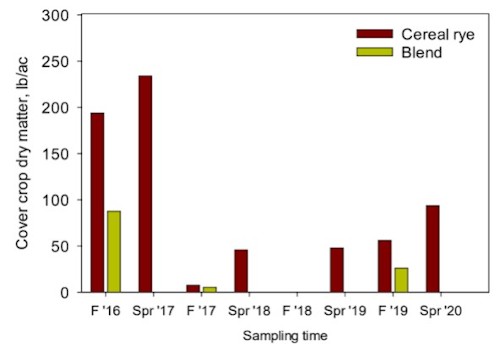By Paul McDivitt
Nitrate loss in surface water and groundwater is an increasingly important water quality and environmental issue in Minnesota. An ongoing study at the University of Minnesota’s Southern Research and Outreach Center (SROC) in Waseca is looking at whether planting cover crops is a viable strategy to reduce nitrate loss in agricultural tile drainage systems.
The video below discusses results from 2016 and 2017 showing that a cereal rye cover crop reduced nitrate loss by an impressive 70% and an annual blend cover crop mix cut nitrate loss by 20%.
However, results from the following years were not as promising. In 2018 and 2019, the cover crops were slow to establish and biomass production was minimal.
“This was likely due to cooler-than-normal October temperatures and greater-than-normal precipitation in September or October in those years,” said Jeff Vetsch, lead researcher on the study and a U of M soil scientist at SROC.
In 2018, cereal rye reduced nitrate by 20% but neither cover crop affected nitrate concentration or loss in 2019 or 2020. Even in the best year (2017), above-ground cereal rye biomass was only about 200 pounds per acre and the annual blend was about 100 pounds per acre. Previous research in southern Minnesota has generated cover crop biomass between 500 and 1000 pounds per acre.
This study clearly shows that if you can establish a cover crop, it can reduce nitrate loss in a tile drainage system. However, the study also highlights the challenge of establishing a cover crop in Minnesota.

Cover crop biomass (pounds per acre) for the cereal rye and annual blend cover crops in the fall and spring of each year of the study.
Cover crops are typically planted in late summer or early fall so that they don’t compete with the crop, hurting the crop’s yield. Due to Minnesota’s cold climate, that means that there’s only a short window for the cover crop to start growing and get established before the winter freeze, and also a short window for the cover crop to reestablish in the spring before it needs to be terminated to plant the next year’s crop.
The study is funded by the Minnesota Corn Growers Association and the Minnesota Corn Research and Promotion Council.
Cost-benefit analysis
There are also other things that farmers need to take into consideration when thinking about cover crops. How much time and money will it take to plant and manage the cover crop? Will the cover crop impact the cash crops in negative ways?
“Economics are the greatest challenge for Minnesota farmers who want to improve surface water quality by using cover crops as a nitrate reduction strategy for tile drainage water,” Vetsch explained.
At the higher broadcast seeding rates used in the study, combined costs for seed and aerial seeding ranged from about $50 to $70 per acre.
"In years with poor prices and average yields, the additional costs of incorporating a cover crop could result in net losses for some growers, especially if they rent the land they farm," said Vetsch.
Additionally, the cereal rye cover crop’s success at reducing nitrate loss in 2017 may have come at a cost. Vetsch found that the following corn crop required about 30 pounds more nitrogen fertilizer per acre to reach its optimum yield than control plots.
“This was due to how effective the spring-terminated cereal rye was at scavenging nitrogen from the soil profile,” he added.
This means that farmers may need to increase nitrogen fertilizer rates the year after starting a cover crop, which further increases their input costs. Although other research suggests that the “lost” nitrogen may release back into the soil in the following years.
This study demonstrates that a cereal rye cover crop can be an effective nitrate reduction strategy for tile drainage water in south-central Minnesota. However, nitrate reduction with cereal rye was not consistent among years and it appears to be contingent on having adequate growth and delaying termination of rye until spring.
“Without financial incentives for farmers, the economics of using cover crops as a nitrate reduction strategy for tile drainage water in a corn-soybean rotation will be challenging,” Vetsch concludes.
Source : umn.edu